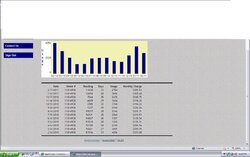Greetings Gents (or 'Gentesses' as applicable)!! =o)
White Pine's recent comment about his power bill prompted me to start a thread - I am heating only 1,700+ sq ft (2 story, but upper floor probably only 35-40% of total area) with a heat pump (single unit, perhaps 5 years old) and I used 4200+ kWhs this past billing cycle. Now, I live near Richmond, VA and, according to the bill, the average daily temp for that time period was 33* = not all that harsh. My house is about 20 years old, and is in good repair.
While my electrical rate is supposed to be something around $.08/kWh, that is rendered pretty much immaterial by the "Wholesale Power Cost Adjustment" fee my electrical cooperative adds in every month. For example, this past month when I used the 4241 kWhs, the "Wholesale Power Cost Adjustment" fee ($115 'WPCA' fee along with the 3 or 4 of the other obligatory penny ante fees/taxes = $.12+/kWh when all considered) turned a $384 outrage into a $518 abomination!! The good news is that it beat my previous "record" by about $22!! :shut:
A couple years ago, I had a rep from the power company come out and give me a "audit" which equated to him wandering around the house with a handfull of other folk's electrical bills which were higher than mine and telling me how lucky I was that mine wasn't higher (okay, that was only 75% of the audit - he did poke around a little, but didn't have any meaningful insights). Not exactly a study in the scientific method! hehe!
All right, all that said to provide a little context. This past month's bill was the Redwood that broke the camel's back; I simply MUST do something different. Given the fact that this forum appears to be a clearing house for guys who have decided to do "something different", I thought I'd stop in here and see if anyone had any ideas where I should start, because I'm not sure what I'm going to do. But I have to do SOMETHING even if it's wrong! :OP
Guidance/Suggestions/Directions/Insults? :O)
Thanks!
Paul
White Pine's recent comment about his power bill prompted me to start a thread - I am heating only 1,700+ sq ft (2 story, but upper floor probably only 35-40% of total area) with a heat pump (single unit, perhaps 5 years old) and I used 4200+ kWhs this past billing cycle. Now, I live near Richmond, VA and, according to the bill, the average daily temp for that time period was 33* = not all that harsh. My house is about 20 years old, and is in good repair.
While my electrical rate is supposed to be something around $.08/kWh, that is rendered pretty much immaterial by the "Wholesale Power Cost Adjustment" fee my electrical cooperative adds in every month. For example, this past month when I used the 4241 kWhs, the "Wholesale Power Cost Adjustment" fee ($115 'WPCA' fee along with the 3 or 4 of the other obligatory penny ante fees/taxes = $.12+/kWh when all considered) turned a $384 outrage into a $518 abomination!! The good news is that it beat my previous "record" by about $22!! :shut:
A couple years ago, I had a rep from the power company come out and give me a "audit" which equated to him wandering around the house with a handfull of other folk's electrical bills which were higher than mine and telling me how lucky I was that mine wasn't higher (okay, that was only 75% of the audit - he did poke around a little, but didn't have any meaningful insights). Not exactly a study in the scientific method! hehe!
All right, all that said to provide a little context. This past month's bill was the Redwood that broke the camel's back; I simply MUST do something different. Given the fact that this forum appears to be a clearing house for guys who have decided to do "something different", I thought I'd stop in here and see if anyone had any ideas where I should start, because I'm not sure what I'm going to do. But I have to do SOMETHING even if it's wrong! :OP
Guidance/Suggestions/Directions/Insults? :O)
Thanks!
Paul


 ! Even in the middle of summer when I am running my pool pump a lot and my AC seemingly non-stop I have never approached anything like that! At most maybe 1800-2000kW. I would ditch the heat pump and start looking into wood burning appliances. I have seen estimates that heating via electricity cost nearly double that of natural gas, wood or wood pellets per BTU. I might start with looking into supplimenting with a pellet stove, if you want to ditch the heat pump all-together you could find a wood or pellet furnance that would do the job nicely for you, but given you heated space you gave I think they might be overkill.
! Even in the middle of summer when I am running my pool pump a lot and my AC seemingly non-stop I have never approached anything like that! At most maybe 1800-2000kW. I would ditch the heat pump and start looking into wood burning appliances. I have seen estimates that heating via electricity cost nearly double that of natural gas, wood or wood pellets per BTU. I might start with looking into supplimenting with a pellet stove, if you want to ditch the heat pump all-together you could find a wood or pellet furnance that would do the job nicely for you, but given you heated space you gave I think they might be overkill.